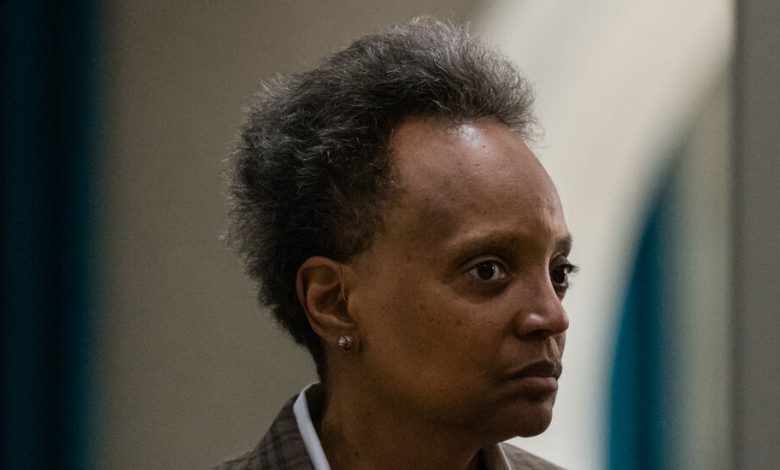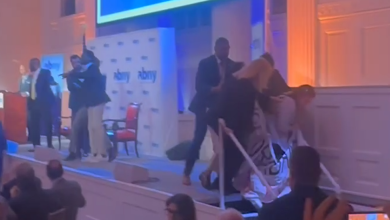After Four Turbulent Years, Lori Lightfoot Seeks a Second Term as Chicago’s Mayor

CHICAGO — Mayor Lori Lightfoot met recently with two dozen Chicagoans at a campaign event in a plush apartment building in the city’s affluent Lincoln Park neighborhood. Before long, she shifted into the rapid-fire mode that defined her career before City Hall, when she was a federal prosecutor known for her tenacity.
She rattled off statistics, handpicked to show that Chicago was on the upswing: The number of shootings in the city had fallen 20 percent in 2022, after spiking during the pandemic. Homicides were down 14 percent. Carjackings decreased, too.
“You know that crime is a complicated issue — you can’t just snap your fingers and make it disappear,” she said, adding: “If you don’t feel safe, none of the rest of it matters.”
Whether Chicagoans believe that the city is getting safer could determine Ms. Lightfoot’s political future. Four years ago, after a politically battered Rahm Emanuel decided not to run for re-election, Ms. Lightfoot emerged from the back of a crowded pack to replace him. She ran as an anticorruption reformer who promised to do away with the old, clubby ways of governing in Chicago. She was elected in a landslide over more prominent, more experienced opponents, sweeping all 50 wards to become the city’s first Black woman mayor.
Less than a year into her first term, though, Ms. Lightfoot, a Democrat, was hit with the Covid-19 pandemic and all its attendant crises — and she now governs a restless city that has yet to fully shake off its pandemic malaise.
Chicagoans have a lot of gripes about the last several years, and many people have laid the blame at Ms. Lightfoot’s feet. Public transit has been shaky, with riders complaining of long waits for buses and “L” trains. Chicago’s school system has steadily lost enrollment, and in 2019, parents endured a teachers’ strike that shuttered schools for 11 days.

Ms. Lightfoot spoke to a small group in a North Side condominium building about her policies on education, crime and other issues.Credit…Jamie Kelter Davis for The New York Times
Above all other issues, crime has unsettled Chicago. Though many kinds of violent crimes fell in 2022, robberies, thefts and burglaries increased from 2021, according to the Chicago Police Department. The North Side is “as safe as it’s been in a generation,” Crain’s Chicago Business wrote in October, but other parts of the city have visibly suffered.
“The city is worse than it’s ever been,” said Pamela Wortham, 65, as she pushed her grocery cart out of a Jewel-Osco store. Her neighborhood, South Shore, has struggled with gun violence and poverty. “But with the right person,” she said, “we could come up again.”
Politics Across the United States
From the halls of government to the campaign trail, here’s a look at the political landscape in America.
- Union Support: In places like West Virginia, money from three major laws passed by Congress is pouring into the alternative energy industry and other projects. Democrats hope it will lead to increased union strength.
- A Chaotic Majority: The defining dynamic for House Republicans, who have a slim majority, may be the push and pull between the far right and the rest of the conference. Here is a closer look at the fractious caucus.
- A New Kind of Welfare: In a post-Roe world, some conservative thinkers are pushing Republicans to move on from Reagan-era family policy and send cash to families. A few lawmakers are listening.
- Flipping the Pennsylvania House: Democrats swept three special elections in solidly blue House districts, putting the party in the majority for the first time in a dozen years by a single seat.
Whether that person is Ms. Lightfoot, who is seeking a second term at City Hall, will be determined in the next few weeks. She is an unpopular mayor whose support has nose-dived in the last four years, in part because of her performance and in part because of the circumstances of the pandemic. Her own polling shows her leading an unwieldy pack of nine mayoral candidates, several of whom have run unsuccessfully before — but it shows her doing so with only 24 percent of the splintered vote.
The mayoral election on Feb. 28 has attracted a long line of challengers, including Representative Jesús G. García, whose Congressional district includes parts of the city, and Paul Vallas, a former head of the Chicago Public Schools. Unless a candidate wins more than 50 percent of the vote — an extremely unlikely scenario — there will be a runoff in April between the two top finishers.
Mr. Vallas, who was endorsed by The Chicago Tribune’s editorial board, has made solving the city’s crime problem his signature campaign issue. Mr. García, the son of Mexican immigrants, would be Chicago’s first Latino mayor; he won enough votes in the 2015 mayoral race to force Mr. Emanuel into a runoff.
Edwin Eisendrath, a businessman and former alderman who has endorsed Mr. García, said that he supported Ms. Lightfoot in 2019 but has been disappointed in her approach to governing.
“We have great universities, we have fabulous neighborhoods, we have important transit infrastructure — in the world of climate change, we have water,” he said, referring to Lake Michigan. “But there’s an enormous leadership gap in Chicago that we all feel, particularly in the last three years.”
Many people point to her temperament. Ms. Lightfoot has sparred with the City Council; the Democratic governor of Illinois, J.B. Pritzker; and legislators in Springfield, particularly over a law that created an elected school board.
The city was focused on rooting out corruption when she was elected mayor four years ago, said David Axelrod, the Chicago-based political strategist.
“She was the outsider prosecutor, the avenger who was going to come in and bring about change,” Mr. Axelrod said. “She’s a very pugnacious person. But the skill set that is required to run a city — you need some of that pugnaciousness, but you also need to cajole, recruit, compromise. The very qualities that made her appealing four years ago may have been a bit of an obstacle here.”
In interviews around Chicago, many residents said they were frustrated with Ms. Lightfoot, bothered by a sense that the city has stagnated under her watch and unsure whether they wanted to give her another chance.
Ms. Wortham said that her neighborhood, South Shore, had deteriorated while other areas of the city, especially on the North Side, have been thriving. She said that when she was a little girl, growing up in the house where she still lives, she could ride her bike to a nearby beach on Lake Michigan without any problems. Now she tells her 10-year-old granddaughter to stay inside, where she is safer.
Ron Bailey, 57, a salesman from the South Side, said he was disappointed that the mayor had not lived up to her promises to overhaul the Chicago Police Department.
“People are still suffering from the pandemic’s effects,” he said. “We see on the news every day what’s going on. There is a crisis of hope in our communities, and unless that crisis is addressed, we’re going to keep getting what we get.”
Jens Ludwig, a professor and the director of the University of Chicago Crime Lab, said that though the numbers of violent crimes have declined, it was not yet clear whether that was the beginning of a longer trend.
“We don’t quite appreciate the effect of the pandemic enough on the crime problem,” he said. “You can see, all sorts of behavior problems have really gone up in the pandemic and post-pandemic period — motor vehicle deaths, disciplinary problems with kids, people fighting on airplanes. All of that stuff is part and parcel of the underappreciated lingering mental health consequences of the pandemic.”
Ms. Lightfoot’s supporters say that her achievements — under difficult conditions — have been understated. The unemployment rate in Chicago is 4.3 percent, down from 18.3 percent in April 2020. The city’s economy remains diverse, a hub of transportation, manufacturing and technology.
Jesse Chacon, 35, who lives on the West Side, said he voted for Ms. Lightfoot once and would probably do so again. “The city’s been good for me and for my family,” he said as he entered an “L” station this month, naming at least four relatives who work in the city’s public schools, fire department or police department.
Under Ms. Lightfoot, Chicago has made progress on improving its finances and has earned upgrades from credit rating agencies. The nonpartisan Civic Federation applauded Ms. Lightfoot last fall for including sizable supplemental payments to the city’s pension funds in her most recent budget, though it criticized her for a lack of transparency on police budgeting.
“A lot of people have a very short memory of all that she accomplished,” said Tamar Newberger, a North Side resident who introduced Ms. Lightfoot at the campaign event on Monday. “The financial health of our city is greatly improved.”
Anton Seals Jr., a founder and community organizer on the South Side, said he has seen a burst in Black entrepreneurship in Chicago in recent years, and praised Ms. Lightfoot for working on initiatives to invest in neighborhoods on the South and West Sides.
“I think, to her credit, what she’s attempted to do is to shine a light and send resources to communities that haven’t gotten it,” he said. “At least in this administration, you’ve had a commitment to try to do something.”
Among the campaign promises that Ms. Lightfoot has yet to fulfill is a vow to draw more people to live in Chicago. Its population grew by nearly 2 percent between 2010 and 2020, to more than 2.7 million people, though the city then lost roughly 50,000 residents during the pandemic, erasing that growth, according to census data.
Juliana Santamaria, 34, a paralegal, is one former Chicagoan who left the city for the suburbs in recent years, driven out of the Pilsen neighborhood when her rent jumped by $400 a month. As she waited for an Uber with a friend in Pilsen this month, she said she missed living in Chicago and was mulling what she would do when her teenage children graduate from high school.
“It’s one of my goals, to move back,” she said.



